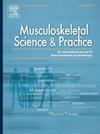优化重度膝骨关节炎的急性疼痛缓解:阻力运动量和心理社会因素的影响
IF 2.2
3区 医学
Q1 REHABILITATION
引用次数: 0
摘要
虽然运动是膝关节骨关节炎(OA)治疗的关键部分,但缓解急性疼痛的最佳剂量尚不清楚。我们的目的是确定老年严重膝关节OA患者诱导运动诱发痛觉减退(EIH)的最佳阻力运动量。方法28例受试者(男女11/17;平均年龄= 71.6±5.2岁),伴有严重膝关节炎,等待单侧全膝关节置换术。他们被随机分为四个实验条件(交叉设计),间隔4天。有弹性阻力的膝关节伸展运动在单次运动中以10次最大重复(RM)强度进行,同时改变组数(不运动的对照组,4组,8组和12组)。结果高运动量组(12组和8组)与低运动量组(4组)或不运动量组相比,运动后10分钟EIH发生率更高,且12组运动干预组差异显著(η2 = 0.472, p <;0.001)。在所有运动干预中,疼痛强度在运动后立即增加,但在4组和12组运动干预中,疼痛强度在10分钟后恢复到基线。在8组和12组运动干预中,患肢和对侧肢体的PPT在10分钟后增加(p <;0.05)。PCS调节了EIH的反应,降低了其在12组中的作用(r = - 0.436, p <;0.05)和8组(r = - 0.418, p <;0.05)运动干预。结论:在严重膝关节炎患者中,更大的阻力运动量似乎与最初的疼痛感知增加以及随后的延迟痛觉减退反应有关。这些探索性发现表明,尽管临床医生应考虑身体和心理因素,平衡短期不适和长期利益,以改善旨在减少该人群急性疼痛的疼痛相关结果,但高强度阻力运动可能是缓解急性疼痛的一种有价值的策略。然而,需要进一步的研究来证实这些影响超出了控制,单一运动急性干预。本文章由计算机程序翻译,如有差异,请以英文原文为准。
Optimizing acute pain relief in severe knee Osteoarthritis: The influence of resistance exercise volume and psychosocial factors
Background
While exercise is a key part of knee osteoarthritis (OA) management, the optimal dose for acute pain relief remains unclear. We aimed to determine the optimal resistance exercise volume to induce exercise-induced hypoalgesia (EIH) in older adults with severe knee OA.
Methods
28 participants (11/17 women/men; mean age = 71.6 ± 5.2 years) with severe knee OA awaiting unilateral Total Knee Arthroplasty were recruited. They were randomised to four experimental conditions (cross-over design) conducted with a separation of 4 days. Knee extension exercises with elastic resistance were performed at single exercise sessions at 10 repetition maximum (RM) intensity, while varying the number of sets (control with no exercise, 4 sets, 8 sets, and 12 sets).
Results
Higher exercise volumes (12 and 8 sets) induced greater EIH 10 min post-exercise compared to lower volumes (4 sets) or no exercise, with significant differences favouring the 12-set exercise intervention (η2 = 0.472, p < 0.001). Pain intensity increased immediately post-exercise in all exercise interventions but returned to baseline after 10 min in the 4- and 12-set exercise interventions. PPT increased post-10 min in the 8- and 12-set exercise interventions for both the affected and contralateral limbs (p < 0.05). PCS moderated the EIH response, reducing its effect in the 12-set (r = −0.436, p < 0.05) and 8-set (r = −0.418, p < 0.05) exercise intervention.
Conclusions
Greater resistance exercise volume appears to be associated with an initial increase in pain perception followed by a delayed hypoalgesic response in patients with severe knee OA. These exploratory findings suggest that higher-volume resistance exercise may be a valuable strategy for acute pain relief, although clinicians should balance short-term discomfort with long-term benefits, considering both physical and psychosocial factors, to improve pain-related outcomes aimed at reducing acute pain in this population. However, further research is needed to confirm these effects beyond a controlled, single-exercise acute intervention.
求助全文
通过发布文献求助,成功后即可免费获取论文全文。
去求助
来源期刊

Musculoskeletal Science and Practice
Health Professions-Physical Therapy, Sports Therapy and Rehabilitation
CiteScore
4.10
自引率
8.70%
发文量
152
审稿时长
48 days
期刊介绍:
Musculoskeletal Science & Practice, international journal of musculoskeletal physiotherapy, is a peer-reviewed international journal (previously Manual Therapy), publishing high quality original research, review and Masterclass articles that contribute to improving the clinical understanding of appropriate care processes for musculoskeletal disorders. The journal publishes articles that influence or add to the body of evidence on diagnostic and therapeutic processes, patient centered care, guidelines for musculoskeletal therapeutics and theoretical models that support developments in assessment, diagnosis, clinical reasoning and interventions.
 求助内容:
求助内容: 应助结果提醒方式:
应助结果提醒方式:


